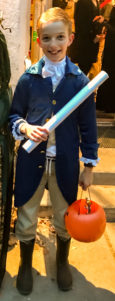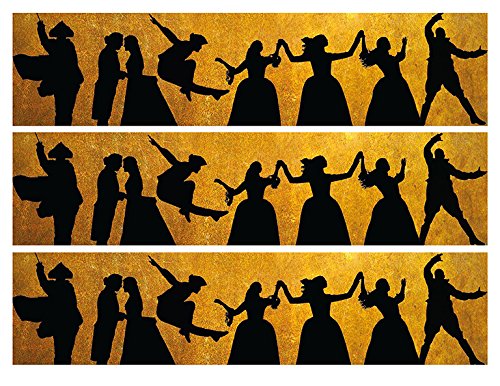One honey-glazed autumn afternoon, I watched a tangle of fifth-graders playing Capture the Flag in a park in Boise, Idaho. Their favorite soundtrack blared in the background:
Alexander Hamilton. My name is Alexander Hamilton.
And there’s a million things I haven’t done.
But just you wait, just you wait…
The singer was, of course, Lin Manuel Miranda, author and star of hip-hop “Hamilton,” the Broadway musical that has been selling out ever since its 2015 debut. I know, I know: I’m way late to this party. The point is, I’ve been dragged here by my 10-year-old son, who – along with the entire fifth grade of Roosevelt Elementary School – is curiously, profoundly obsessed with “Hamilton.” And now I have these kids to thank for introducing me to one of the most brilliant pieces of narrative writing I have ever encountered.
One day after school, my son Austin tugged on my elbow and said, “Hey Mama, listen to this!” He then recited, from memory, without missing a beat, an entire song from Hamilton. This from a kid who has never listened to rap or shown any interest in theater. His obsessions are predictable 10-year-old boy obsessions: Legos, superheroes, riding bikes, and poking at things with sticks. Yet out of his mouth spilled this narrative scene – written entirely in dialogue – between Alexander Hamilton (the hero) and Aaron Burr (the sympathetic villain):
Pardon me. Are you Aaron Burr, sir?
That depends. Who’s asking?
Oh, well, sure, sir.
I’m Alexander Hamilton. I’m at your service, sir.
I have been looking for you
I’m getting nervous…
Sir…
I heard your name at Princeton.
I was seeking an accelerated course of study
when I got sort of out-of-sorts with a buddy of yours.
I may have punched him. It’s a blur, sir. He handles the financials...
You punched the bursar?
Yes! I wanted to do what you did. Graduate in two, then join the Revolution.
He looked at me like I was stupid. I’m not stupid.
So how’d you do it? How’d you graduate so fast?
It was my parents’ dying wish before they passed.
You’re an orphan. Of course! I’m an orphan.
God, I wish there was a war!
Then we could prove that we’re worth more
Than anyone bargained for.
Can I buy you a drink?
That would be nice.
While we’re talking, let me offer you some free advice:
Talk less…
What?
Smile more.
Ha.
Don’t let them know what you’re against or what you’re for.
You can’t be serious.
You wanna get ahead?
Yes.
Fools who run their mouths off wind up dead.
Once I recovered from the twitterpation of hearing my kid rapping about 19th-century American history, I realized just what I was hearing: next-level narrative craftsmanship.
This quippy exchange does a ton of heavy lifting. It introduces the hero and the villain. It develops their characters with important backstory: they’re both orphans; both college-educated; both poised on the brink of the American Revolution. It foreshadows the clashing philosophies that underpin their rivalry: Hamilton wants to take a stand and fight; Burr demurs, preferring to avoid conflict. This motif resurfaces throughout the story.
I realized just what I was hearing: next-level narrative craftsmanship.
That’s a lot to accomplish in one scene. Miranda does it in 203 words…of pure dialogue. Check it out: There’s no expository backstory. No character description. No scene-setting. Granted, if you were sitting in a Broadway theater, you’d witness those elements playing out visually on stage. But I first listened to “Hamilton” while staring through my windshield on a two-day drive, and I swear I saw 3D characters dancing across the lonely Wyoming highway.
Maybe I just needed more coffee. But I’ll bet you two ten-dollar bills it’s because writing is the real star of “Hamilton.”
Take the rhythm. The language is filled with alliterative tap-dancing and literal cadence that ranges from old-school Shakespearean meter (It was my parents dying wish before they passed) to something more modern, like literary step-dancing (Then we could prove that we’re worth more than anyone bargained for). Bang out that last line on a mental snare drum. Hear the syncopation?
The rhyming schemes are just as deft. Miranda's rhymes are like card tricks, and he employs every trick in the book: internal rhyme (put a pencil to his temple, connected it to his brain); alliteration (meddling in the middle of a military mess); assonance (pick a place to die where it’s high and dry); consonance (revolutionary manumission abolitionists). Or, in the case of this tongue-twistery tirade by Thomas Jefferson, all of the freakin’ above:
I’m in the cabinet. I am complicit in
watching him grabbing’ at power and kiss it
if Washington isn’t gone’ listen
to disciplined dissidents, this is the difference:
this kid is out!
Sparring characters complete each other’s couplets, sometimes in the very act of cutting each other off. Listen to this debate between George Washington and Thomas Jefferson, arguing over American involvement in the impending war between France and England:
We’re too fragile to start another fight.
But sir, do we not fight for freedom?
Sure, when the French figure out who’s gonna lead ‘em.
The people are leading—
The people are rioting.
There’s a difference.
Frankly, it’s a little disquieting
you would let your ideals blind you to reality.
Hamilton…
Sir?
Draft the statement of neutrality.
Unspoken rhymes dangle in the missing beat of an unfinished sentence. Like this one, as Hamilton reads an extortive letter from his mistress’s cuckold husband:
Dear Sir, I hope this finds you in good health
and in a prosperous enough position to put wealth
in the pockets of people like me: down on their luck.
You see, that was my wife who you decided to…
I’ve listened to the soundtrack all the way through several times, initially forced by my son and his friends, and later of my own volition. It’s like re-reading Shakespeare, or mining Tolstoy. Each revisit teases out a new layer of meaning, wordplay and craft. I’m a shameless fan of paranomasia, but Miranda elevates the pun from its unsung reputation as the “lowest form of humor.” In trying to define his double entendres, I’ve learned all sorts of new technical terms: syllepsis, zeugma, paraprosdokian.
It’s like re-reading Shakespeare, or mining Tolstoy.
It took me several listens to fully appreciate Hamilton’s narrative architecture. The story structure is braided together with motifs – both melodic and lyrical – that converge in a spectacular mashup at the end of Non-Stop, the final song in Act I. The main refrain, “I am not throwing away my shot!” evolves, meaning one thing in the beginning and something very different by the end.
Linguistic gymnastics aside, here’s Hamilton’s dopest trick of all: getting fifth-graders pumped about history and politics – two subjects I dreaded at that age.
These kids are not just grooving on the music; they’re actually grasping the politics. In two “cabinet battles,” Hamilton and Jefferson debate fundamental governmental issues in a rap-battle that makes heckling an art form. Cabinet Battle #1 is, in the words of my fifth-grade son, “about Hamilton’s new form of government, and whether that made sense.” I probed: What exactly does that mean? “Assume state debts,” Austin said without looking up from his Legos. Cabinet Battle #2 is about “whether we should help France,” and contains one of his (okay, our) favorite riffs in the whole musical:
We signed a treaty with a king whose head is now in a basket.
Would you like to take it out and ask it?
“Should we honor our treaty, King Louis’ head?”
“Uh…do whatever you want, I’m super dead.”
I wondered if this fifth-grade obsession was a phenomenon unique to Roosevelt Elementary, our tiny public school in Boise, Idaho. I assume most of these kids have not seen the musical (the nearest traveling show was four-and-a-half hours away, in Salt Lake City). Yet they’re writing history reports on Hamilton, dressing up like him for Halloween, and inflicting upon teachers and parents this revolutionary earworm.
Turns out, it’s not just Roosevelt grooving on “Hamilton.” Fellow parents in other fly-over states confirmed: their fifth graders are into it, too. Why? Because fifth grade is when social studies classes cover the American Revolution. While some teachers may be jumping on this opportunity (see: The English Teacher’s Guide to the Hamilton Musical), it appears most kids are discovering it on their own.
“Only great works of literature have this many layers.”
~ Samantha Harvey, professor of English, Boise State University
"I wonder if children are attracted to its underdog storyline?” mused Samantha Harvey, a fellow Roosevelt mom and a tenured English professor at Boise State University. “The coming-of-age story – Hamilton coming to the U.S., finding his friends and his purpose – might perfectly resonate with fifth graders navigating their social worlds and their first introduction to their government: democracy led by the people (and their peers)."
Harvey and I met through our sons; Austin and Leo are classmates. While living in Boston on an East Coast fellowship, she took Leo’s sister to see the show on Broadway when Delphi was 12. (Leo declined, but now says he kind of regrets it.) Delphi came home obsessed, and Harvey impressed – not only with the performance, but the way it engages minds of all ages.
“By turning the congressional debate into a rap battle, it is a truly democratic exercise of blending formal government with the voice of the people,” she wrote in an email over Thanksgiving. Wielding a PhD in English Literature from Cambridge University, Harvey can declare with more authority than I: “Only great works of literature have this many layers.”
Word!

Austin swears he’s “not obsessed” with “Hamilton.” But I hear him rapping himself to sleep at night. He was introduced to “Hamilton” by another classmate, Thor, who loves soccer, basketball, and Legos. Thor Trick-or-Treated as the founding father and tosses beanbags at a corn-hole game he painted with the “Hamilton” logo. It was Thor’s birthday wish to play Capture the Flag while listening to his favorite tunes.
I asked Thor how he got into “Hamilton.” “Friends,” he said. Rap and hip hop weren’t really his jam, but there was something about “Hamilton” he found irresistible. “I started listening to it,” he said, “and I couldn’t stop listening to it.” Thor had the soundtrack memorized by the time his mother took him to see the musical in Las Vegas last June. “I loved the writing, the rhyming, and the choreography,” he told me. As a pleasant side effect, he retained more than a little history. “I used to get the Civil War and the American Revolution mixed up.”

“Hamilton” shows the power of storytelling to bring history to life in the minds of kids. It is a masterpiece adults should study for its Olympic-level craftsmanship. What can we as narrative nonfiction writers learn from this and apply to our own writing? That there’s always more to learn, and it can come from anywhere. And thanks to my son, I can say this:
There’s a million things I haven’t done.
Carving Alexander Hamilton into a pumpkin?
(Wait for it…)
No longer one of ’em.



